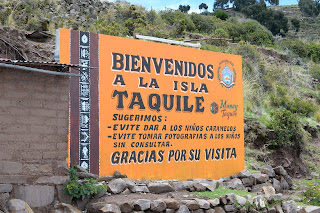Play me the song of life
To
sing or to steel – some of the street children in Cusco, Peru, have a choice. A
Danish farmer and a Peruvian sociologist have established a home for the
youngest exposed in the city: Inti Runakunaq Wasin – the House of the Sun
Folks
Christmas celebration at Inti
 The
Virgin Mary stands in a light-yellow dress by the window. If the porcelain
figure could speak, she would tell us about 65 expectant faces.
The
Virgin Mary stands in a light-yellow dress by the window. If the porcelain
figure could speak, she would tell us about 65 expectant faces.
The
day-care centre Inti Runakunaq Wasin - in English the House of the Sun Folks -
is placed in the quarter San Jeronimo, Cusco, the Andes in Peru. The Dane Jens
Laurits Sørensen was the initiator of the project 19 years ago.
In
1995 Jens left Denmark and went travelling. The trained farmer had shortly
before sold his farm and wanted to see the world. This brought him for the
first time to Peru. In the centre of the old Inca city Cusco is Plaza De Armas
located, and there the street children were hanging out. It made a big
impression on Jens to see the children; some of them just three – four years
old, roam around, dirty and hungry. They polished shoes all day long, snorted
glue, stole from the tourist or sold themselves (for sex). It was all about
survival and had nothing to do with a dignified life. Jens began to talk with
the children, invited them in smaller groups for a bite of bread, and slowly
confidence was build.
Four years later in 1999, after many trips between Copenhagen and Cusco,
and after having taken out a significant personal loan, Jens started a day-care
centre for the street children. They could come by daily and get a glass of
milk, be together with adults, rest, get inspiration and hope for a better
life.
What started out with a piece of bread now consists of four creative
day-care centres for poor children and young kids. Inti today has 11 employees,
including a psychologist.
 The charismatic sociologist Luz Marina Figueroa Arias leads the project.
She has gathered her experiences from Inti in the book ”Niños en riesgo camina al empredimiento” – ”Children at risk under upbringing” and thereby
gave voice to the children. One of these children is Washington, 12 years old: “... we
live in two rooms, which my mother rent. It is not long ago we moved. My mother
takes care of us. She sells potatoes in the market and earns two Peruvian Nuevo
Sol (0,52 Euro) per portion, and sometimes she doesn’t sell
anything. My father is a bricklayer, but he doesn’t always have a job and when
he earns something, he uses it on booze. Each time he comes home drunk, he
beats my mother, and me too, mainly because I try to protect her. My small
sisters and brothers get very scared, they begin to cry and run away to hide in
the rocks outside and they don’t return until my father sleeps or has left the
house…”
The charismatic sociologist Luz Marina Figueroa Arias leads the project.
She has gathered her experiences from Inti in the book ”Niños en riesgo camina al empredimiento” – ”Children at risk under upbringing” and thereby
gave voice to the children. One of these children is Washington, 12 years old: “... we
live in two rooms, which my mother rent. It is not long ago we moved. My mother
takes care of us. She sells potatoes in the market and earns two Peruvian Nuevo
Sol (0,52 Euro) per portion, and sometimes she doesn’t sell
anything. My father is a bricklayer, but he doesn’t always have a job and when
he earns something, he uses it on booze. Each time he comes home drunk, he
beats my mother, and me too, mainly because I try to protect her. My small
sisters and brothers get very scared, they begin to cry and run away to hide in
the rocks outside and they don’t return until my father sleeps or has left the
house…”
Three
years after the establishment of the street children-project in Cusco, Jens
founded a Danish NGO (Non-Governmental Organization) Solens Boern – The Children of the Sun.
The purpose of the organisation is to support poor and exposed children
and young kids, predominantly with Indian origin in Cusco, Peru, and mainly the
street children-project Inti. It is possible to work as a volunteer and trainee
in the day-care centre. But it is important to have Spanish knowledge in order
to be able to establish the close contact with the children, that is the main
purpose of the project. But even more important for the survival of the project
is economic donations.
The organisation is one of few support projects in Peru. The GNP (Gross National
Product) of Peru is raised and that has caused many NGOs to draw their support,
but the need for help is still big.
The Danish NGO has 227 members and assists with support from private
persons, businesses and organisations like Merkur Fonden, J.
Lauritzen Fonden, Tipsmidlerne and Lions Club. The donations are tax-deductible.
The administration-costs in 2013 are expected to be 4,35 percentage, a
very low share in comparison to other organisations. This is a clear advantage
for the children as more funds go directly to them. Despite that Inti still
needs around 1500 Danish Krones equal 200 Euro a month - otherwise Juan Choque
Cuadros can no longer teach music to the children at Inti Runakunaq Wasin.
IBAN: DK6784010001038589
SWIFT: MEKUDK21
More information:

































PER_0412.JPG)
PER_0419.JPG)
PER_0429.JPG)
PER_0443.JPG)
PER_0477.jpg)
IMG_1323.JPG)
PER_0614.JPG)
PER_0636.jpg)
IMG_1329.JPG)
IMG_1332.JPG)
IMG_1344.JPG)
PER_0562.JPG)

PER_0529.JPG)
PER_0572.JPG)
IMG_1348.jpg)
IMG_1369.jpg)
image.jpeg)
IMG_1360.JPG)
PER_0527.JPG)
IMG_1374.JPG)
PER_0575.JPG)
PER_0594.JPG)
IMG_1378.JPG)
PER_0629.JPG)